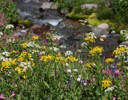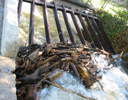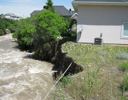The dominant plant communities found in Salt Lake County can be more or less roughly correlated with elevation. Use this map, and the native plant lists on the following pages, to identify the best plants for your landscape.
While elevation is a good climate predictor—lower elevations are generally hotter and drier, higher elevations are cooler and moister—other factors play a role in creating microclimates within the elevation zones. The north-facing slope of a canyon will support plants that prefer cooler and moister conditions, while the south-facing slope at the same elevation will support plants that favor warmer, drier conditions. Stream corridors are another type of microclimate, given the regular presence of water and a greater abundance of shade. This allows plants found along streams to transcend some of the boundaries dictated by climate and elevation. This is particularly true in the hottest and driest areas of the watershed, where the riparian corridor is visibly obvious as a "green ribbon" of trees and shrubs. Native plants of the Intermountain West occupy an amazing range of microhabitats.
Use the map of elevation zones in Salt Lake County and the Native Plants Lists as a guide to determine which plants could be best suited for improving native plant diversity in your landscape. Use what you know about the unique microclimate of your property—sun, shade, water availability (do you have irrigation for the drier upper slopes?), soil type, etc.—to select plants that will thrive in your landscape.
Let's say, for example, you live at the lower edge of the Foothill Zone (at approximately 4,900 feet) on a north-facing slope and you have a nice canopy of big shade trees along your stream. Your shady streamside microclimate may support plants that occur naturally at higher elevations (cooler, moister) in the Mid-Montane Zone.










